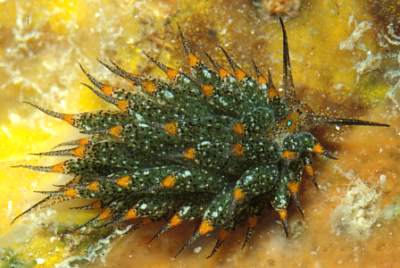
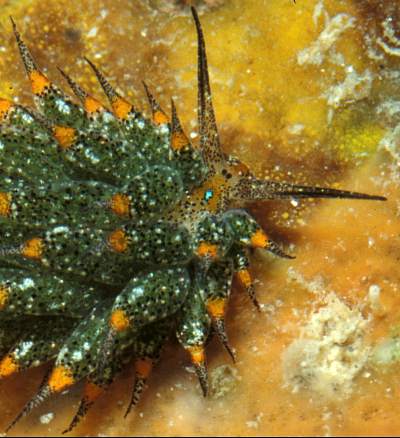
Costasiella ocellifera
(Simroth, 1895)
Order: SACOGLOSSA
Superfamily: LIMAPONTIOIDEA
Family: Costasiellidae
DISTRIBUTION
Caribbean
PHOTO
Lark Cay, Belize. Photo: Jeff Hamann
Body translucent clear, covered with black spots. The head can have orange yellow patches, and the large black eyes, close together between the rhinophores are very prominent. The rhinophores are long and tapering with the black spots increasing in density so that the upper half is almost black. Behind the rhinophores, in the midline is a characteristic blue spot, which is bordered with a thin line of black, brown or orange. The name 'ocellifera' refers to this ringed blue spot. The inflated cerata narrow to a long thin tapering tip. The ceratal wall is transparent with black spots, and the ceratal digestive gland ducts are green from being filled with green chloroplasts. There can be scattered bluish-white patches on the ceratal wall, and there is a subapical orange yellow band around the cerata, just down from the tip. The black spots become more crowded near the tip. This species was originally described from Bermuda as Doto ocellifera. Clark (1984) redescribed this species from Bermuda and reported that it was common on Avrainvillea. Redfern (2001) reports that it is also common in the Bahamas.
Clark (1984) proposes that Costasiella lilianae (Marcus & Marcus, 1969), originally described from Brasil, is a synonym. I do not know if it is important, but in the colour description of C. lilianae I can see no mention of the blue spot behind the rhinophores. Other aspects of the colour pattern are identical.
References:
• Clark, K.B. (1984) New records and synonymies of Bermuda opisthobranchs (Gastropoda). The Nautilus, 98(2): 85-97.
• Marcus, Ev. & Marcus, Er. (1969) Euthyneure Meeresschnecken Brasiliens. (2). Beitrage zur Neotropischen Fauna, 6(1): 1-16.
• Miles, C.M. & Clark, K.B. (2002) Comparison of biochemical composition and developmental mode in two populations of Costasiella [Opisthobranchia: Ascoglossa (=Sacoglossa)]. Journal of Molluscan Studies, 68: 101-109.
• Redfern. C., 2001. Bahamian Seashells: a Thousand Species from Abaco, Bahamas
• Simroth, H., 1895. Opisthobranchia Gymnobranchia.Die Gastropoden der Plankton Expedition, 2: 1-206
Rudman, W.B., 2002 (October 8) Costasiella ocellifera (Simroth, 1895). [In] Sea Slug Forum. Australian Museum, Sydney. Available from http://www.seaslugforum.net/find/costocel
Related messages
Costasiella ocellifera from Barbados
April 4, 2006
From: Kira Alleyne
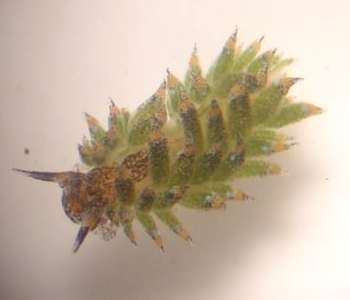
I found this little creature while snorkelling at Bath, St. John and was hoping someone could identify it for me. I am student at the University of the West Indies: Cave Hill Campus doing research on the Opisthobranchs of Barbados.
Locality: Beach, 0.5m, Barbados, Caribbean Sea, March 23rd 2006, Intertidal. Length: 6mm. Photographer: Nicole Marshall.
Kira Alleyne
kira_alleyne@hotmail.com
Alleyne, K., 2006 (Apr 4) Costasiella ocellifera from Barbados. [Message in] Sea Slug Forum. Australian Museum, Sydney. Available from http://www.seaslugforum.net/find/16178Dear Kira,
This is a little sacoglossan called Costasiella ocellifera. It is usually associated with it food plant Avrainvillea.
Best wishes,
Bill Rudman
Costasiella ocellifera from St. Vincent
October 28, 2005
From: Les Wilk
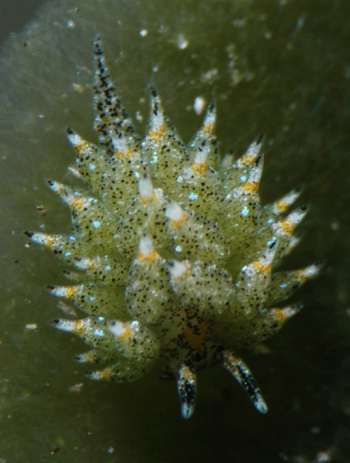
Hi Bill;
We found about a dozen of these Costasiella ocellifera at one of the St. Vincent dive sites. Although less than a quarter inch long, the pictured specimen was the largest.
Locality: west coast St. Vincent Is., Caribbean. Depth: 30 feet. Length: 0.125 - 0.250 inch. July 2005. sandy area near patch reef. Photographer: Keri Wilk
Les Wilk
wilk@reefnet.ca
Wilk, L., 2005 (Oct 28) Costasiella ocellifera from St. Vincent. [Message in] Sea Slug Forum. Australian Museum, Sydney. Available from http://www.seaslugforum.net/find/15054Thanks Les,
Bill Rudman
Re: Costasiella ocellifera - one species or two?
March 8, 2004
From: Marina Poddubetskaia
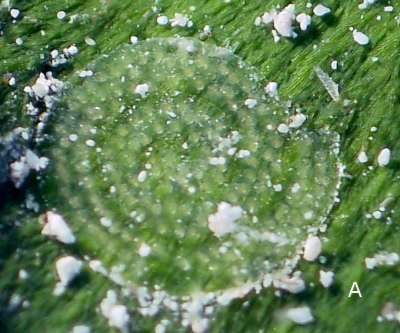
Dear Bill,
I was interested in reading your thoughts about Costasiella ocellifera larval development [#12361]. It reminded me of a little mystery I met in the Northern Bahamas. I'm not sure this information will be useful for you, but here is the story...
One day I was snorkelling in the Bimini Road site. It is a sandy area with many alga including the Udotea in the lower photo of my message about Elysia papillosa from Northern Bahamas [#12335]. Please, note that this alga looks similar to the one in my message #12277, but I'm sure it's not the same.
So, in Bimini Road this Udotea is very common but scattered over a large area. I noted there that many leaves of this alga had one (and only one) egg-ribbon like in attached photos A and C. These eggs was so numerous that I wanted to discover the sacoglossan which lays them. For up to one hour I checked all the algae of this species and I didn't find any sacoglossan on it, only egg-ribbons. It was completely incredible to see such a huge number of eggs and no one living animal. After my snorkelling I continued with the scuba dive in the same area. At the end of my dive I succeeded in finding one Elysia papillosa on this alga: it is the one in my message #12335.
However I can't decide whether these eggs all belong to one species. In fact, these eggs look very similar to the Costasiella ocellifera ones from the Southern Bahamas [#12277]. But here they clearly correspond to a direct larval development. Moreover, the lower left animal (Costasiella ocellifera) from my message #12276 was found in the same area, but on the sand. So, we can be sure that Costasiella ocellifera is present here too.
Do you think these eggs could belong to Costasiella ocellifera? If so, it would be an illustration of the direct larval development in this species. As for the second egg-ribbon [photo B], I saw it only one time and it probably belong to another species.
Bimini Islands, Bahamas, Western Atlantic. Site: Bimini Road. Depth: 1-2m. February 12, 2004.
Diameter of egg ribbons: A: 6mm., B: 7mm., C: 7mm
Photos: Marina Poddubetskaia - Nembro website
I hope this little mystery is interesting for you.
Best wishes,
Marina.
nembro@nembro.info
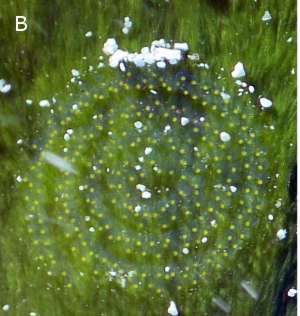
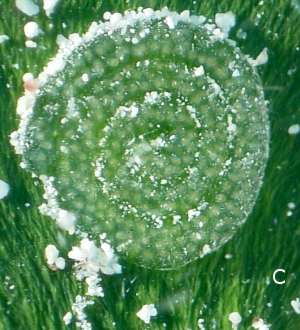
Thanks Marina,
It's certainly irritating when you find lots of eggs and no obvious layers. Both the ribbons you illustrate here are different from your earlier photo of the egg ribbon of Costasiella ocellifera. Also Costasiella seems to feed exclusively on Avarianvillea so it is unlikely to have laid its eggs on a species of Udotea.
Elysia papillosa has lecithotrophic development [see Jensen message #5967] so it is possible the large eggs in your common egg,ass belong to that species.
Best wishes
Bill Rudman
Re: Costasiella ocellifera development types
March 4, 2004
From: Skip Pierce
Hi Bill
-This seems to be sacoglossan week. the situation you've described for Costasiella ocellifera in the Keys [#12361] reminded me of a paper I published 100 years or so ago (with Hillary West and June Harrigan -Veliger 26: 199-206) on Elysia chlorotica - same reproductive issue north and south of Cape Cod. Northern slugs are basically direct developers - veligers passed entirely in the egg - maybe a short (24hr or less) free swimming period. Southern slugs have a lengthy (couple of weeks) planktonic veliger. Clearly the 2 populations are the same species - we crossed them several times. As I recall the F1's had a sort of intermediate result - ie, shorter planktonic stage than the southern slugs, but longer than the northern. The environments north and south of the Cape are quite different with regard to things like summer water temps - but we never fooled around with that. Geographically the 2 populations are maybe only 50 miles apart - separated by the Cape, of course, but conjoined by the Cape Cod Canal which the southern veligers could easily traverse in a tidal cycle. So I agree that differences such as those you've pointed to in C. ocellifera in the Keys probably shouldn't be used at the species level without something else.
• West, H.H., Harrigan, J.F. & Pierce, S.K. (1984) Hybridization of two populations of a marine opisthobranch with different developmental patterns. The Veliger, 26(3) 199-206.
Skip
pierce@cas.usf.edu
Pierce, S.K., 2004 (Mar 4) Re: Costasiella ocellifera development types. [Message in] Sea Slug Forum. Australian Museum, Sydney. Available from http://www.seaslugforum.net/find/12362Thanks Skip,
Yes the sacoglossans are certainly getting a good run this week
Bill Rudman
Costasiella ocellifera from Bahamas
March 3, 2004
From: Marina Poddubetskaia
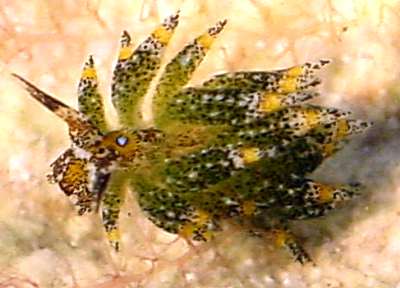
Dear Bill,
Here is another sacoglossan from the Bahamas: Costasiella ocellifera. I saw it in quite large numbers in Exuma, just near Anne DuPont's boat and I found one specimen in the Northern Bahamas.
One of the attached photos shows this species on its alga and you could see how well this species is hidden in its environment. So, I don't need to explain you why I had to move them on a neutral place to have visible photos.
Upper & Lower right: Great Exuma, Bahamas, Western Atlantic. Site: Stocking Island, Hole n°2. Depth: 1m. 5 February, 2004. Size: 5-6mm long.
Lower left: Bimini Islands, Bahamas, Western Atlantic. Site: Bimini Road. Depth: 2m. 12 February, 2004. Length: 5mm.
Photos: Marina Poddubetskaia - Nembro website
Best wishes,
Marina.
nembro@nembro.info
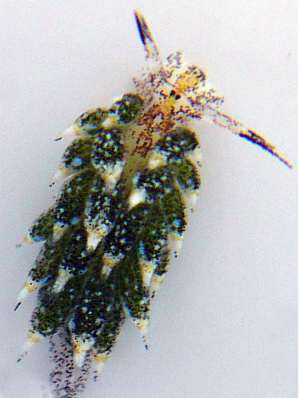
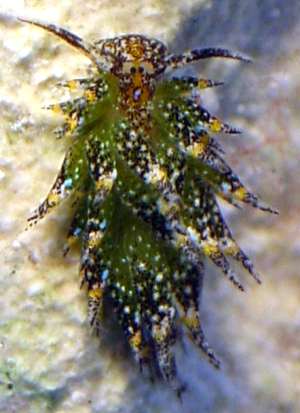
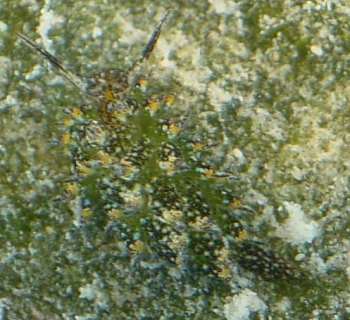
Thanks Marina,
As your photo alongside shows, these animals are quite hard to see when on their food plant.
Best wishes
Bill Rudman
Costasiella ocellifera: alga and egg-ribbons
March 3, 2004
From: Marina Poddubetskaia
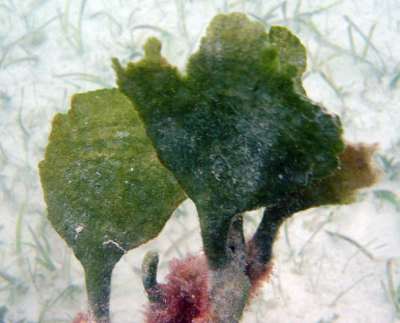
Dear Bill,
To accompany my previous message on Costasiella ocellifera, [#12276] here is a photo of the alga on which I've found all the specimens seen in Southern Bahamas (Stocking Island).
Also, I have seen several translucent small egg-ribbons on this alga. But I didn't have any evidence that they belonged to this species. So, Anne and I, we decided to put 3 Costasiella specimens in the tank with their algae. Several hours later we noted these 2 egg-ribbons here, 3mm in diameter. They are very similar to the ones I saw 'in wild', but probably infertile. So, now I'm pretty sure they belong to this species.
Photos: Marina Poddubetskaia - Nembro website
Cordially,
Marina (and Anne).
nembro@nembro.info
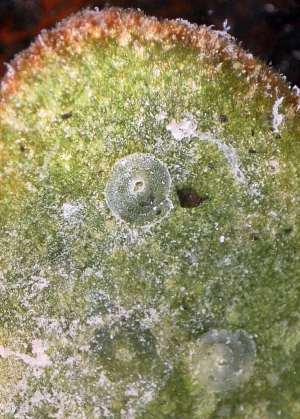
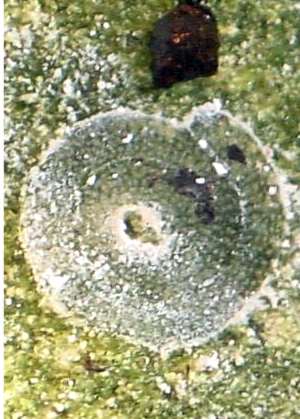
Dear Marina,
Thanks for these photos. I assume this alga is Avrainvillea nigricans and hopefully a local expert can confirm that name. I read somewhere recently that some algologists consider there to be more than 20 species of the genus in the Caribbean, which doesn't augur well.
The egg ribbon is also interesting. Firstly could you check whether it is possible the photo was reversed in your scanning? I have a photo of this species egg ribbon which coils the opposite way. Either yours or theirs is reversed or the slug doesn't care which way it coils. Of special interest is that a paper has recently been published suggesting that there are two species of Costasiella which are impossible to distinguish externally - one with this type of egg ribbon and one with a different ribbon. See my separate message [#12361]
Best wishes
Bill Rudman
Costasiella ocellifera - one species or two?
March 3, 2004
From: Bill Rudman

Marina Poddubetskaia's recent message [#12277] which includes a photo of an egg ribbon laid by Costasiella ocellifera raises a very interesting topic. Miles & Clark (2002) suggest that what we call C. ocellifera is in fact two species which seem identical externally but have quite different larval development which can be clearly seen in their egg ribbons. They also suggest the two 'species' can be distinguished on their habitat preference, although they both feed on Avrainvillea nigricans.
They describe two egg ribbons, one which gives rise to planktotrophic veliger larvae and one in which direct development occurs, small crawling slugs hatching from the egg capsules. The egg ribbon photographed by Marina alongside, is identical to their photo of the ribbon of the planktotrophic larval type. Its eggs hatch in about 6 days and there are about 10 times as many eggs as in the direct-developer's egg ribbon, which takes 12 days to hatch. The direct developer's egg ribbon is of similar diameter to the other but the individual eggs are about 40% larger [106 and 76 microns respectively].
The authors consider the habitats of the two 'species' are also significantly different, with the direct developer being found in the Upper Florida Keys, occupying a mangrove fringe habitat where their algal food, Avrainvillea nigricans, is tall and abundant. The planktotrophic species by comparison was found in the Lower Florida Keys in an exposed coral sand habitat where A. nigricans is shorter and less densely spaced.
Miles & Clarke consider the planktotrophic developer is the true Costasiella ocellifera while the direct developer is a distinct but unnamed species. Since we don't know the development type of Simroth's original material this could become a nomenclatural problem. Also Costasiella lilianae Marcus, 1969 has been considered a synonym of C. ocellifera but I note that Clark & Jensen (1981) describe its development type as direct [capsular metamorphic]. As Marcus didn't describe the development type for this species either it could become quite confusing.
The first question though is whether this is a case of poecilogony in which one species can have more than one development type, or whether we are dealing with two species which can only be distinguished by watching them lay their eggs.
• Miles, C.M. & Clark, K.B. (2002) Comparison of biochemical composition and developmental mode in two populations of Costasiella [Opisthobranchia: Ascoglossa (=Sacoglossa)]. Journal of Molluscan Studies, 68: 101-109.
Best wishes
Bill Rudman
Costasiella ocellifera in Jamaica
October 7, 2003
From: Ross W. Gundersen
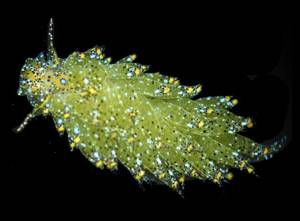
Dear Bill:
Here is another sea slug from Jamaica. As I said in my first message, all specimens were collected from St. Ann's Bay, Jamaica, West Indies. Most specimens were collected using a light weight dredge and photographed by R. Gundersen.
Here is Costasiella ocellifera. Dredged at 5 m depth in Thallassia.
Best wishes,
Ross
ross.gundersen@uwp.edu
Gundersen, R.W., 2003 (Oct 7) Costasiella ocellifera in Jamaica. [Message in] Sea Slug Forum. Australian Museum, Sydney. Available from http://www.seaslugforum.net/find/11110Thanks Ross,
This is a very distinctive species. I have no hesitation in confirming your identification
Best wishes
Bill Rudman
Costasiella ocellifera from Dominican Republic
April 30, 2003
From: Elianny Dominguez
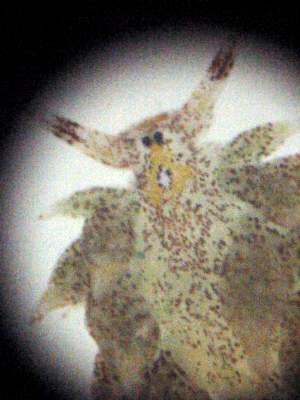
Dear Bill,
I found this nudibranch on Udotea sp, at 44 ft. in the Dominican Republic. It is 5 mm long, and 2 mm width. Its tail was very long - almost half the body length
Any idea?
Elianny Dominguez Tejo.
eliannydominguez@hotmail.com
Dear Eli,
You are lucky your photo caught the two good external features of this species - the eyes very close together mean it is a species of Costasiella, and the orange-yellow ring just behind them identify it as Costasiella ocellifera. The orange ring is supposed to surround a black-ringed blue spot, but I am sure your animal is just a variation of this. I assume the 'DR' in your message meant Dominican Republic? Some fuller locality data would be useful. I'm afraid I can't see enough in your other photo to have any idea what it is
Best wishes,
Bill Rudman
Costasiella from Belize
October 12, 2002
From: Dave Behrens


Dear Bill,
We have had this Costasiella from Lark Cay, Belize, in the Caribbean for years. We called it Costasiella liliana. I notice that it is listed as Costasiella ocellifera in Redfern (2001). Can one of our sacoglossid experts clear this one up? Photo is by Jeff Hamann.
Dave Behrens
Dave@seachallengers.com
Behrens, D., 2002 (Oct 12) Costasiella from Belize. [Message in] Sea Slug Forum. Australian Museum, Sydney. Available from http://www.seaslugforum.net/find/8151Dear Dave
Clark (1984) proposed that Costasiella lilianae (Marcus & Marcus, 1969), originally described from Brasil, is a synonym of Costasiella ocellifera. I do not know if it is important, but in the colour description of C. lilianae I can see no mention of the characteristic 'ocelli' or blue eye spot behind the rhinophores. Other aspects of the colour pattern are identical.
Cheers,
Bill Rudman
